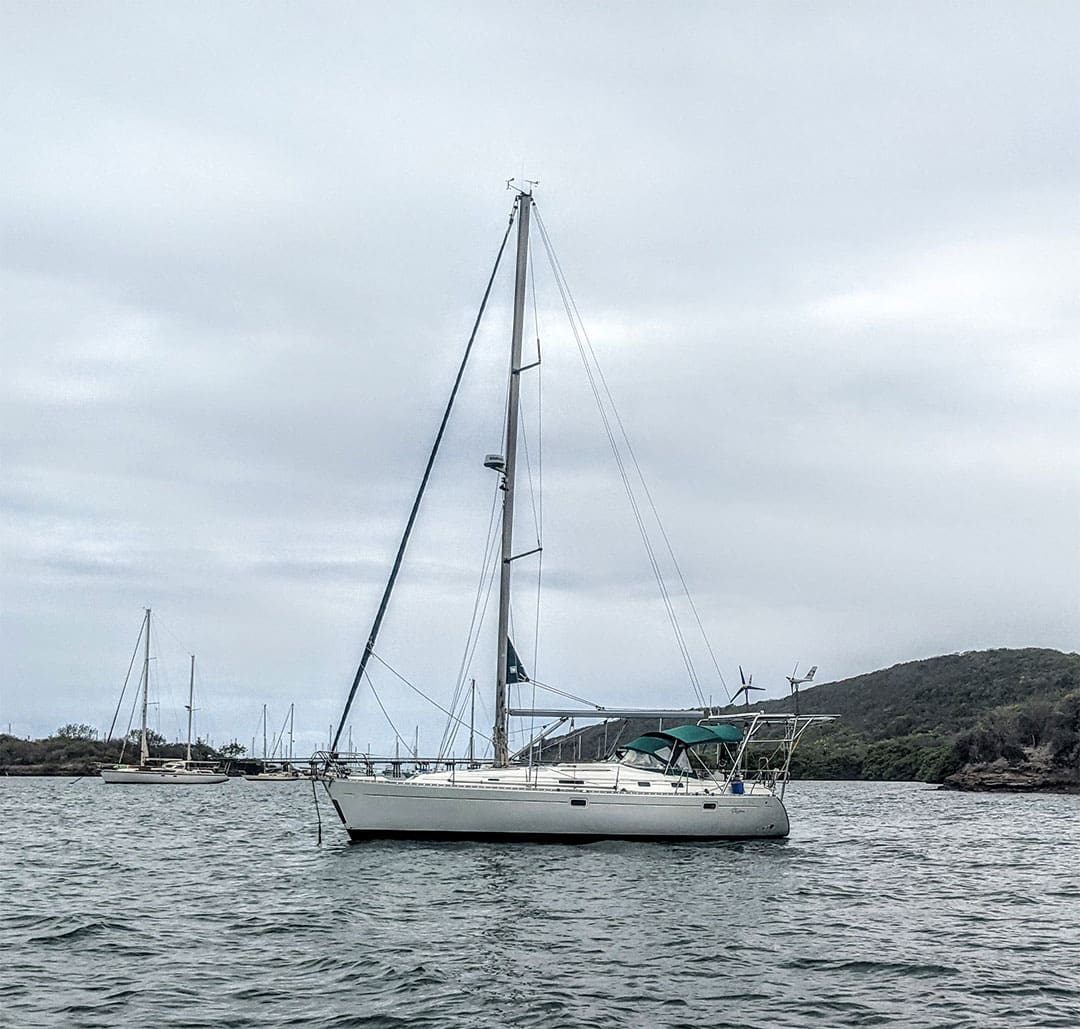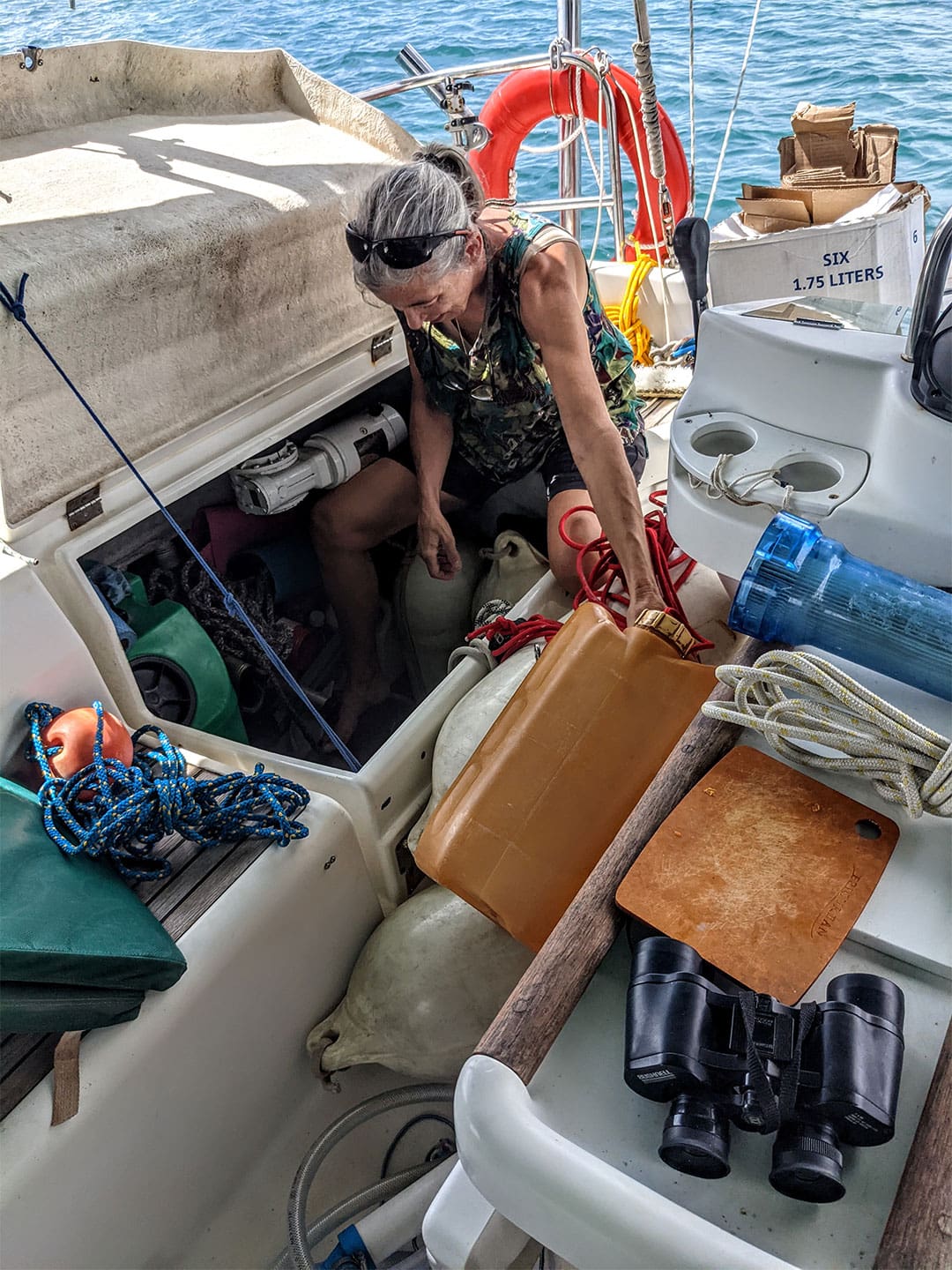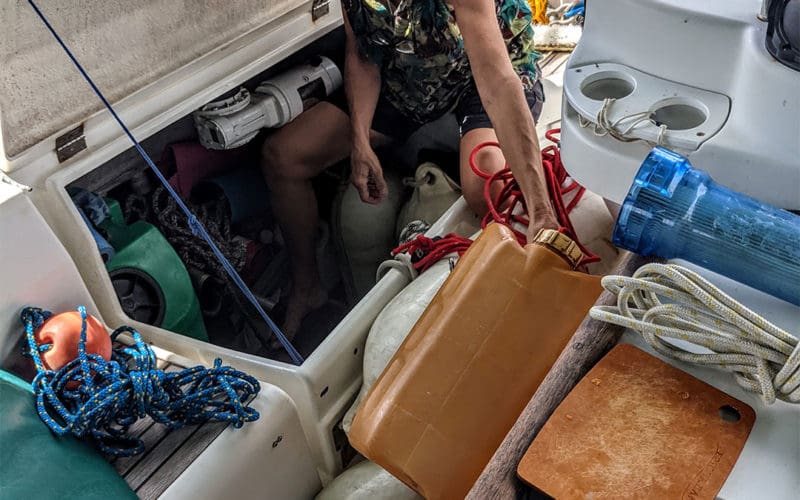
Kerivan’s Beneteau Oceanis 381 Camino.
The excitement of being new sailboat owners was wearing off quickly. My wife and I had been aboard our new-to-us 2000 Beneteau Oceanis 381sailboat for only a few hours when we made an unpleasant discovery: the forward and aft head holding tanks were both full; moreover, the blackwater hoses leading away from each tank were solidly sclerotic. Our blackwater plumbing was constipated.
Up in the cockpit, the starboard lazarette, where the aft holding tank was mounted, had been torn apart. Fenders, lines, and spare anchors littered the space. My wife and I looked around, dazed. We were on a mooring ball in Woburn Bay, Grenada, where our boat, Camino, was lying when we purchased her. Not only were we new to sailing and living aboard, we were new to Grenada. We tried to figure out our options — something that didn’t involve dinghying to the nearest marina every time nature called.
Toilet trouble was nothing new for us. For 17 years we owned a small inn in Vermont, and plumbing fails were common. Guest were always cheerful when announcing to a full breakfast room, “My toilet doesn’t work.” But marine plumbing was a different creature. There were hidden hoses and valves and hand pumps. But still, the basic principles should still apply, and our long tenure dealing with clogged toilets gave us the DIY confidence to tackle the problem.
When we were shopping for our sailboat, holding tanks had been very much on our minds. Having grown up on the South Shore of Massachusetts and spent a lot of time around the boating world, I was aware of U.S. regulations with respect to blackwater. As we considered boats, we were surprised to learn just how many lacked holding tanks, instead having a direct discharge line to the sea.
So finding a boat with adequate holding tanks was a must on our list. At the time, we wanted the option of taking the boat back to U.S. waters, which would require holding tanks to facilitate either a pump out or a trip to the three-mile offshore mark to discharge the blackwater. But we never thought our boat would be delivered with full holding tanks.
Not long after we were aboard Camino for the first time, a friendly sailor stopped by to say hello and ask how we were getting on. We told him about the full tanks and our situation and he rolled his eyes. We asked him what other boaters in the bay did with their holding tanks, and he just winked and mentioned the outgoing tide. Chantal and I looked at each other desperately: Really? Is this what the liveaboard life is all about? It was a low moment.
We quickly began to evaluate our situation and make a plan. As far as we knew, there were no pump-out services in any of Grenada’s southern bays — something confirmed by the friendly sailor who stopped by earlier. We also needed to inventory our gear and figure out if this was a problem we could fix ourselves, or if we needed to find professional help. Based on the equipment we found aboard — buckets and hoses and scoops — we got to work on fixing the problem.

Kerivan works on getting to the holding tank outlet hose.
The first step was to empty the holding tanks. Since the outlet hoses were calcified shut, this meant opening the tanks and scooping and siphoning out the wastewater. It was as horrible as it sounds, but after an hour of sweating and cursing, the aft tank was mostly empty.
Next, we needed to clear the outlet hose that led to a valve and an opening in the hull, where the wastewater was discharged. This meant emptying the entire lazarette, because the outlet hose ran across the bottom of the storage space: more sweating and grunting.
But how to clear the hose? When we described our problem to some of the other sailors we encountered at the marina’s happy hour, we received advice that spanned the spectrum of solutions.
“Buy new hoses.”
“Pour acid into the tank.”
“Call Palm Tree Marine.”
None of those appealed to us. Our decision-making tree always goes from the simplest and cheapest solution to the most complicated and costliest. That’s why when someone suggested we get a hammer and smack the hose to break up the solidified material, we thought we would give that a try. After hanging upside down and rapping on the hose, I could hear a crackling. A few more whacks and I heard the solid material in the hose break apart and rush out, followed by the remains in the holding tank, which we helped flush with some seawater.
After verifying that the entire vascular system worked from toilet to exit valve, we collapsed in the heat and immediately began making plans to eat food again.
We learned some valuable lessons because of this situation. The first is that we probably should have ordered the broker back onto the boat and demanded the tanks be cleaned and made functional. But that wasn’t part of the survey (the manual toilets flushed, but nobody checked the holding tanks).
Since we had no intention of repeating this process, we set a regular schedule for discharge and maintenance of the holding tanks. Each time they are emptied they are treated with fresh water and vinegar to prevent the buildup of material in the pipes. They also get a dose of vegetable oil to keep the gaskets happy. These simple fixes have provided us with headache-free heads for the last year. But the experience taught us a couple of valuable lessons: first, problems must be anticipated and addressed quickly; and second, be prepared to deal with someone else’s crap. As a wise sailor once said, it’s all part of the adventure. n
Shawn Kerivan is a writer, teacher, and sailor. He and his wife Chantal live aboard their 38-foot Beneteau Camino.

